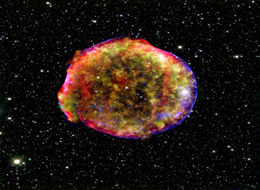
Multiwavelength X-ray / infrared image of SN 1572 or Tycho's Nova, the remnant of a Type Ia supernova.(NASA/CXC/JPL-Caltech/Calar Alto O. Krause et al.)
A team of astronomers, led by Dr. Bo Wang from the Yunnan Observatory of the Chinese Academy of Sciences, have developed a new model which explains the formation of the most youthful type Ia supernovae. In a paper published in Monthly Notices of the Royal Astronomical Society, Dr. Bo Wang and his team show how the transfer of material from a 'helium star' to a compact white dwarf companion causes these cataclysmic events to take place early on in the life of the galaxy they formed in.
Most type Ia supernovae are believed to occur when a white dwarf (the superdense remnant that is the end state of stars like the Sun) draws matter from a companion star orbiting close by. When the white dwarf mass exceeds the so-called Chandrasekhar limit of 1.4 times the mass of the Sun, it eventually collapses and within a few seconds undergoes a runaway nuclear fusion reaction, exploding and releasing a vast amount of energy as a type Ia supernova. Due to their high and remarkably consistent luminosities, astronomers use these events as 'distance indicators' to measure the distances to other galaxies and constrain our ideas about the Universe.
Scientists have confirmed more and more type Ia supernovae, and found that about half of them explode less than 100 million years after their host galaxy's main star formation period. But previous models for these systems did not predict that they could be this young so Dr. Wang and his team set out to solve this mystery.
Employing a stellar evolution computer code, they performed calculations for about 2600 binary systems consisting of a white dwarf and a helium star, a hot blue star which has a spectrum dominated by emission from helium. They found that if the gravitational field of the white dwarf pulls material from a helium star and increases its mass beyond the Chandrasekhar limit, it will explode as a type Ia supernova within 100 million years of its formation.
The team now plans to model the properties of the companion helium stars at the moment of the supernova explosions, which could be verified by future observations from the Large sky Area Multi-Object fiber Spectral Telescope (LAMOST, http://www.lamost.org/en/ ). Team member Prof. Dr. Zhanwen Han comments, "Type Ia supernovae are a key tool to determine the scale of the Universe so we need to be sure of their properties. Our work shows that they can take place early on in the life of the galaxy they reside in."
The team's results can be found at http://xxx.lanl.gov/abs/0901.3496 (From RedOrbit)





